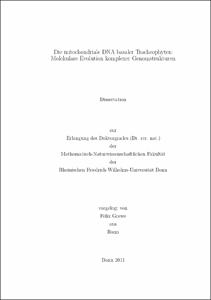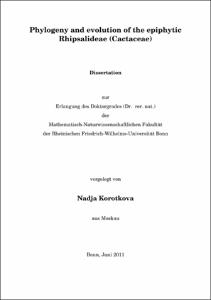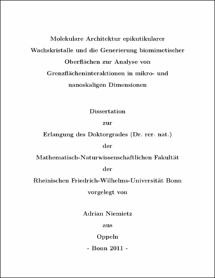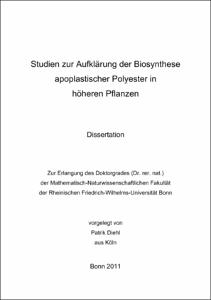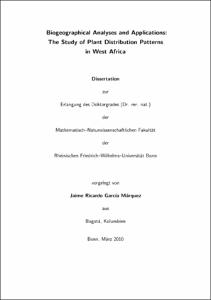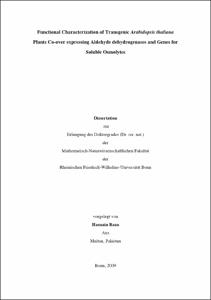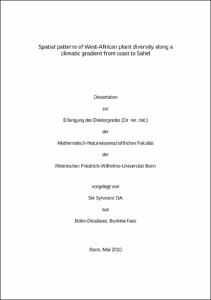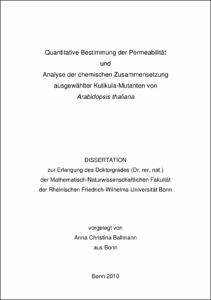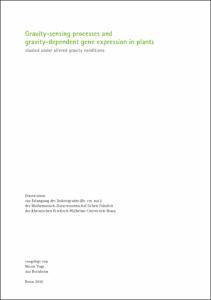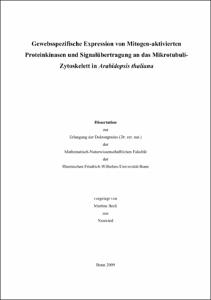E-Dissertationen: Suche
Anzeige der Dokumente 1-10 von 63
Die mitochondriale DNA basaler Tracheophyten: Molekulare Evolution komplexer Genomstrukturen
(2011-05-26)
Aufgrund ihrer hohen Komplexität ist die Anzahl vollständig sequenzierter pflanzlicher mitochondrialer Genome (Chondrome) noch gering. Sie beschränkt sich auf die vollständig ermittelten mtDNA-Sequenzen einiger Angiospermen ......
Phylogeny and evolution of the epiphytic Rhipsalideae (Cactaceae)
(2012-01-11)
Cactaceae are one of the major floristic components of the New World’s arid as well as seasonally moist tropical regions and at the same time one of the most popular plant families in horticulture. The taxonomic units ...
Molekulare Architektur epikutikularer Wachskristalle und die Generierung biomimetischer Oberflächen zur Analyse von Grenzflächeninteraktionen in mikro- und nanoskaligen Dimensionen
(2011)
Die Ziele dieser Arbeit waren die Gewinnung neuer oder die Bestätigung bzw. Widerlegung bekannter Ergebnisse im Forschungsbereich epikutikularer Wachsstrukturen. In drei aufeinander aufbauenden und verknüpften Schwerpunkten ...
Studien zur Aufklärung der Biosynthese apoplastischer Polyester in höheren Pflanzen
(2011-11-15)
Suberinablagerungen in den Wurzeln höherer Pflanzen tragen entscheidend zur Regulation des Wasserhaushaltes bei. Sie ermöglichen der Wurzel eine selektive Aufnahme von Nährstoffen, erlauben den Ausschluss toxischer Substanzen ...
Biogeographical Analyses and Applications: The Study of Plant Distribution Patterns in West Africa
(2011-03-10)
Studies and applications in biogeography aim at understanding the causes and determinants of past, current, and future diversity distribution patterns. In this context, niche models are currently important tools. They make ...
Functional Characterization of Transgenic Arabidopsis thaliana Plants Co-over expressing Aldehyde dehydrogenases and Genes for Soluble Osmolytes
(2010-09-16)
Plant growth and productivity is largely hampered by a number of abiotic stresses. These stresses affect the physiological and metabolic pathways leading to the production of many harmful substances like aldehydes, reactive ...
Spatial patterns of West-African plant diversity along a climatic gradient from coast to Sahel
(2010-07-20)
Understanding species distribution patterns and the corresponding environmental determinants is a crucial step in the development of effective strategies for the conservation and management of plant communities and ecosystems. ...
Quantitative Bestimmung der Permeabilität und Analyse der chemischen Zusammensetzung ausgewählter Kutikula-Mutanten von Arabidopsis thaliana
(2010-12-22)
Die Kutikula bildet die Grenzfläche zwischen den oberirdischen Pflanzenorganen und der Umwelt. Für viele Spezies (z.B. P. laurocerasus) wurden bereits transportphysiologische Untersuchungen mit isolierten Kutikularmembranen ...
Gravity-sensing processes and gravity-dependent gene expression in plants: studied under altered gravity conditions
(2010-11-05)
The present study focused on the cellular and molecular gravisensing-related processes in Arabidopsis and in the unicellular rhizoids of the green alga Chara. Experiments during sounding-rocket and parabolic plane flights ...
Gewebsspezifische Expression von Mitogen-aktivierten Proteinkinasen und Signalübertragung an das Mikrotubuli- Zytoskelett in Arabidopsis thaliana
(2010-01-04)
In dieser Arbeit sind drei MAPK aus A. thaliana näher charakterisiert wurden. Wie bereits bekannt ist, sind MPK3, MPK4 und MPK6 an vielen abiotischen und biotischen, sowie entwicklungsspezifischen Signalwegen beteiligt. ...


